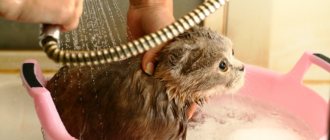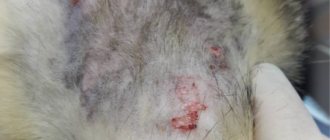Curious kittens often find themselves in situations where they urgently need to be washed. Often, the owner’s arsenal lacks the necessary supplies to maintain hygiene. If a careless dirty fellow has soiled the whole house, you need to know how to wash the cat if there is no special shampoo.
Under natural conditions, they maintain cleanliness on their own by licking their fur. If the kitten is very dirty, first wipe it with a damp cloth. Wipes soaked in lotion are not suitable for this. Only as a last resort use household chemicals. A clean pet must be wrapped up to prevent it from catching a cold.
If your pet is very afraid of water
Veterinarians advise not to rush into water procedures, but to give the baby time to adapt to a new place and get used to people
You can accustom your pet to water procedures only after changing teeth. When the kitten has played enough and is tired, well-fed, healthy and happy. The baby should see that his owners are not afraid of water, wash themselves often, and this is a natural process for all family members. Cats are observant and intelligent; they notice and remember a lot.
If your kitten is unsure about its cleanliness, it is best to treat it with flea and tick spray and give it a deworming tablet.
When bathing for the first time indoors, nothing should distract or frighten the animal. If the first procedure does not go smoothly, the next one will be even more difficult. The cat should be washed by a person she trusts. The first bath should be short so that stress does not last long. Your pet should not be allowed to freeze, as it will remember not only water procedures, but also the cold after them.
If at each subsequent bath the cat behaves inappropriately and as if doing it for the first time, it is better to give up trying and switch to partial washing or using dry shampoo. The product is sold in pharmacies just for those animals that are terribly afraid of water. Dry shampoo is a spray that is applied to the coat and then thoroughly combed out by the pet owner. The product copes well with pollution, protects the pet’s nervous system and maintains a trusting relationship between the animal and the person.
Other options for ridding an animal of dirt
With partial cleaning, the pet gets rid of dirt, and its psyche remains protected
You can also bathe not the entire animal, but only the back, sides, tail or paws. All you need is a minimum of water, a good sponge, a brush and a little patience. A wet rag does not scare a cat as much as a container of water or a strong stream of water. Contaminants are removed using special products or dry shampoo. You need to move the sponge or brush strictly according to the hair growth, not forgetting that you cannot stroke the cat against the grain, as he does not like it.
Tail
It should be handled with caution, since felines themselves are sensitive to their mood indicators. You shouldn’t pick it up, squeeze it, or twist it in different directions.
You need to lightly touch the sponge and gently move it, washing away the dirt, holding the cat by the head. Paws. They can be wiped with a cloth or dipped in a shallow container with soapy water. Cats that often walk outside get used to this procedure just as well as dogs. Sides. A greasy side, stomach or back can be washed off with a spray that will need to be removed with a brush, or a wet sponge with a special detergent. Muzzle. It is easy to clean with a damp cloth or bring the animal to a water tap and wash it gently, taking care not to get water into the nose or ears. Head. The cat cannot reach everywhere to lick itself, and on the head, between the ears, its fur sometimes becomes greasy. It is recommended to wash contaminated areas on the head with dry shampoo or under a low-pressure tap if the animal is not afraid of such procedures.
Application for lichen
In folk medicine, laundry soap is used to treat lichen. The pathological area must be lubricated daily with thick soap suds. This treatment option is used when the lichen is dry. Before the first application, cut off some of the fur around the rash.
The skin disease can be easily treated with medications that can be purchased at the pharmacy. For example:
- Unisan;
- Clotrimazole;
- Thermikon;
- Exoderil;
- Liverazole;
- Terbinafine;
- Imaverol;
- Marfloxin.
To increase the effectiveness of treatment, it is necessary to normalize the pet’s diet and give medications that boost the immune system. For general strengthening of the body, the veterinarian may prescribe Cycloferon or its analogues.
Preparing to wash
Let's find out whether it is possible to wash a cat with human shampoo or baby
shampoo. When using various spray shampoos, remember that many cats can be scared by whizzing sounds. In this case, you should stop using such shampoos.
But before washing a cat using liquid shampoos, you need to carefully prepare. Firstly, you don’t need to feed your pet before bathing (4 hours before). Secondly, there is no need to demonstratively make noise with basins or water, since the cat is a very sensitive animal. She may get worried and hide from you. The best thing to do is try to calm the cat down, for example, pick it up and stroke it.
Why does a washed weasel fight after the procedure?
Sometimes, after water treatments, pets become aggressive and fiercely defend themselves, attacking the owner or not allowing him to approach them. Usually this does not happen, but some individuals are overly excitable and impressionable. This especially happens if the cat was washed by force or was frightened by something during bathing, for example, a loud sharp sound or a sudden change in water temperature.
Knowing the characteristics of your pet, you can in some cases avoid such behavior. Before water procedures, cats with an excitable nervous system are given a sedative. The drug, its dose and administration order are prescribed exclusively by a veterinarian.
When your pet fights after bathing, you should not force communication on him. It is better to treat your pet with treats, offer an interesting toy, speak in a soothing tone, but do not try to stroke it. When the cat pacifies its ardor, you can gently scratch it behind the ear, gradually establishing contact.
If your cat is stressed during bathing, it is likely that the pet will find it difficult to tolerate further water procedures. Therefore, it is important to behave correctly, adhere to the rules of washing cats and treat your pet with understanding.
How often to wash a cat
Is it possible to wash a cat with regular human shampoo?
Cats should only be washed when circumstances require it:
It is also important to remember that there are a number of contraindications to bathing procedures for cats:
- animal disease;
- late stages of pregnancy;
- postoperative period.
Also, the cat should not be washed for two weeks after vaccination.
But even if the animal is completely healthy, frequent bathing should still be avoided, otherwise the cat's immune system will fail, which will lead to severe illness or death of the animal.
If a cat does not leave the house, and the owner carefully cares for its fur, such an animal should be washed once every 3 months. If the cat walks outside, the animal should be washed once every 1.5-2 months. Not more often. The exception is hairless cats - in winter they are washed once a month, and in summer once every 2 weeks.
Cat breed
: yard.
Asks
: Basilisk the Beautiful.
The essence of the question
: how to bathe a cat if there is no shampoo?
Our cat ran outside in the morning, for the first time in 5 years. The cat is neutered, we were surprised ourselves. Came in the evening of the same day. We wanted to give him a bath yesterday, we don’t know where he was climbing. And we don’t even have cat shampoo. And there are no veterinarians nearby either.
Among many cat lovers, there is an opinion that pets should not be bathed, but sometimes there is an urgent need to wash the cat. And these are not only cases when it gets very dirty, but also, for example, preparation for an exhibition.
The following two tabs change content below.
I am a veterinarian in one of the clinics in the city of Gomel (Belarus). I myself am an experienced cat lover, I have two Don Sphynxes. I love these animals very much and they love me back. These are charming cats - Marfa and Petrovna.
Cats should not be bathed often.
What products, besides special shampoo, can be used to wash cats?
Cats have very sensitive and delicate skin, and their acid-base balance is very different from human ones. That is why, if you decide to wash your pet with your regular shampoo, you should choose the mildest possible product.
The ideal option is shampoo for children.
An incorrectly selected cat wash product can result in such unpleasant consequences as:
- skin irritation;
- deterioration of coat condition. If the product is not chosen correctly, the cat's fur can become brittle and dull;
It is recommended to wash your cat with shampoo if you want to give its fur a beautiful and well-groomed look. If the animal just gets dirty, you can wash off the dirt with clean warm water.
To do this, just wet a piece of soft cloth in water and thoroughly wipe your pet, paying special attention to contaminated areas.
There are situations in which bathing a cat can lead to dangerous consequences for its health. These include cases such as:
- old age of the animal
. Such cats and cats are more susceptible to stress than young individuals, and every bath can be a serious test for their nervous system; - the animal has recently undergone surgery
; - There is cold air in the apartment or constant drafts
. In this case, the pet may freeze after bathing in warm water.
In most cases, cats are able to keep themselves clean without water or shampoo. To prevent fur from accumulating in the furry pet’s stomach after active licking, owners should give it special vitamins that help remove fur naturally.
Tar soap
Tar soap occupies a special place among cosmetic cleansers. Outwardly, it resembles ordinary laundry soap, but it has a different smell - birch tar, very pungent. Tar makes up approximately 10% of the total composition of the product; everything else is sodium chloride, water, palm oil and fatty acids. They ensure good latherability of the product, and the essential oil softens the effect of alkali.
Tar soap looks similar to laundry soap, but may be a little darker
Tar soap is used mainly to combat small parasitic insects (lice, fleas), which are repelled by its pungent, disgusting smell. But this product has two very useful properties: it heals well and disarms wounds. Parasites feed on the blood of humans and animals, secreting their saliva into our body, which causes an allergic reaction in the form of a burning sensation and rash. For animals, this is unbearable pain; they try to tear the sore spot with their claws, wounds form into which various microbes and bacteria can penetrate, causing inflammation. Tar soap disinfects areas of the skin damaged by pests, reduces pain and itching, and makes it easier for your pet to endure the consequences of the lives of its “inhabitants.”
Tar soap can drive away insects and relieve their bites
Benefits of tar soap:
- environmentally friendly product;
- high alkaline balance;
- has disarming and calming effects;
- low cost;
The disadvantages of this product include:
- contraindication for allergy sufferers: an allergic reaction to tar may occur;
- It is contraindicated for people and animals with thin and dry skin: the skin will become even drier, irritation may occur, even small open cracks;
Tar soap does not kill parasitic insects, it only scares them with its smell, and they escape from the pet’s fur. However, their eggs remain, from which new individuals subsequently hatch, capable of reproduction and parasitism, so you will have to wash your pet with tar soap several times.
Fleas run away from the smell of tar soap, but their eggs remain, so several procedures are needed
Animals have a more delicate sense of smell than people, so the smell of tar soap may be unpleasant to them - you should not leave soap suds on your fur for very long.
Soap dries the skin a little. But only those dogs who have very short and soft hair. For sphinxes or hairless crested animals (CHS) and similar animals, I would not recommend using this soap for bathing. Dries your skin in one go. It dries, not because it’s bad, but because it disinfects and kills germs. Soap acts as an antiseptic and has a positive effect on the skin of animals. But only for dogs and cats! Under no circumstances should you wash rabbits, mice or other animals! Tar soap contains birch tar. No unhealthy fragrances or additives. Clean product! If you are ready to endure the tar smell and are familiar with it, then feel free to buy this soap) It seems to me that it is much more effective than Celandine shampoo. Well, the fact that soap will rid your pet of fleas is a nice addition!
Ksyusha25
https://otzovik.com/review_1135246.html
How and when to wash a kitten for the first time and with what
How often can you wash a kitten?
Unless there are any special circumstances, a mother cat successfully cares for her babies, including their fur. In the first month from birth, healthy kittens do not need bathing.
- baby may get scared
- if he's with his mom, she might not recognize him as smelling like shampoo
- The baby has not yet established thermoregulation, he may freeze and get sick
So, the decision was made to wash the kitten. What's the best way to do this?
The procedure should be carried out 2 hours after feeding the kitten. It is necessary to prepare the bathing area so that cat shampoo and two terry towels are at hand. How to choose a shampoo can be read below. It is better to bathe a kitten not in the bathtub, but in the sink and basin. Lay a terry towel or cotton sheet on the bottom. Approximately 5 cm of water is collected in a sink or basin. Her temperature is measured. 38 degrees is the optimal indicator. It is better to turn off the tap while bathing the kitten; the noise of the water may frighten it. You can wash off the shampoo with a ladle or a mug. If the wool is dense, it can only be washed with running water; the stream from the tap or shower should not be under high pressure. The kitten should not be immersed in water abruptly, starting with its hind legs.
At the same time, it is important to stroke him and calm him down. Perhaps, like a child, a kitten will tolerate bathing more easily if it has balls and toys - squeakers - that will distract it from the unpleasant procedure. You need to water the kitten's body very carefully, making sure that water does not get into the eyes and ears. The shampoo should be rinsed off the fur thoroughly. After bathing, your baby should be wrapped in a towel to keep him warm.
When the towel gets wet, it should be replaced. Dry the kitten's fur with a soft brush or hairdryer if he is not afraid of it.
Adaptations
To make bathing a cat easier, some pet product manufacturers offer assistive devices. The meaning of such devices is similar, but the designs are slightly different.
Cat washing net
Bag
This is a small round bag with a drawstring top, made of thick waterproof fabric. Place the cat inside and fill it with water and dissolved detergent. Only the pet's head is left outside, tying the strings of the bag under the chin.
Thus, the cat is immersed in water, but cannot escape or harm the owner. It is convenient to use for bathing struggling cats, especially if you need to soak them for some time in an antiparasitic, dermatological or other solution.
Net
It is sewn like a bag, but has small slits, which is why the order of use is different. Also in this mesh bag there are holes for the paws and tail, which can be zipped if necessary. The cat is placed inside and then bathed as usual. Such a device significantly limits the pet’s movements, which helps protect the owner from injuries that can be caused by a violent animal under stress. The mesh also reduces the cat's attempts to escape to almost nothing.
Cat bathing cage
Cell
In practice, bags are less common, but sometimes you can come across such a device. It is a metal structure with a flat bottom and a semicircular top, flattened on the sides.
Designed to restrict the cat's movements. There is enough distance between the bars to stick your fingers through and wash the cat, but at the same time the cat cannot get out of the closed cage or turn around in it. In such a device you can not only bathe, but also dry your pet with a hairdryer.
You should remember the safety rules for using such devices. Before use, you must check the integrity of the device and its reliability. You cannot leave a cat in a constrained state for a long time, this can have a bad effect on its physical and psychological condition. Bathing bags and cages should not be used unnecessarily. As in any other case, you must praise and encourage the cat; you cannot scold, raise your voice, or scare. After bathing, you need to treat him with a treat.
What should you wash your cat with?
Shampoos for cats
At the moment, there are several types of shampoos intended for cats:
Dry shampoos
are an ideal option for washing a cat, as they are easily applied to the fur, and after a certain time they are simply combed off along with various dirt. Such shampoos are very effective and are in no way inferior to liquid shampoos. In addition, they also make combing much easier.
Benefits of dry shampoo:
Thus, thanks to dry shampoos, you can easily rid your pet of dirt without harming his health. It is worth noting that such shampoos are ideal for frequent use, since they do not dry the skin and, moreover, do not damage the protective fat layer of the hair.
Liquid shampoos
have a fairly high cleaning efficiency. Such shampoos perfectly remove various dirt, while making the coat silkier and smoother. In addition, liquid shampoos are more specialized; they can be used against ticks, fleas, and so on. It is worth noting that such shampoos should be used no more than 2 or 3 times a year, as they can disrupt the functioning of the sebaceous glands. An exception may be situations if the wool is very dirty, especially with various synthetic substances.
Shampoo sprays
Quite a rarity, since they are not often found in various pet stores. They are very convenient to use, just like dry shampoos, but unlike dry shampoos, sprays can provide antistatic protection to the animal’s fur. After using this shampoo, the coat is quite easy to comb. It is also worth noting that spray shampoos have a more pronounced perfume smell.
Will this soap help?
Does tar soap help get rid of Ctenocephalides canis or Ctenocephalides felis fleas?
Yes, this insecticide instantly and permanently kills fleas on the fur of a cat or dog. With the help of such a product, the pet owner completely destroys all parasites.
However, such treatment of an animal is a labor-intensive process. Ideally, tar soap should sit on dog or cat hair for about 30–40 minutes. with each application to destroy all parasites, but you can reduce this time to 10 minutes.
Composition and beneficial properties
Tar soap has a variety of insecticidal and medicinal properties.
This product consists of the following components:
- birch tar. Birch tar is very toxic to fleas Ctenocephalides canis, Ctenocephalides felis or other parasites. Also, such tar is a good antiseptic that slows down and stops the growth of various bacteria or fungi;
- phenol, cresol and alkali. These chemicals, which are part of the soap, leave various chemical burns on the body of fleas, from which they then die;
- sodium salts, which maintain salt and water balance in the skin.
It is also beneficial to use tar soap when ridding your pet of Ctenocephalides canis or Ctenocephalides felis fleas for the following reasons:
- small price - 20 rubles. for 1 piece At the same time, specialized various products for certain types of fleas cost 10 or more times more;
- such soap is safe for both pets and their owners;
- it does not cause allergies with frequent use.
First bath
Since most cats are afraid of water, the pet may show strong resistance, so it is necessary to trim its claws in advance.
How to wash a dusty “sofa” pet for the first time if it is already an adult and there was no reason to subject it to an unpleasant procedure. By following step-by-step instructions, you can make this process less painful for yourself and your frightened animal.
You need to fill the bathtub with water and watch the reaction. If he is not afraid of the sound of the water, it is possible that he will take bathing calmly. And when you decide to wash your animal, you need to follow these steps:
- Decide on a swimming place. This could be a bathroom, kitchen, hallway or yard if the weather outside is summer.
- Outdoors and indoors, you need to stock up on water and all the necessary supplies: shampoo, brush and towel. Place them in such an order that it is easy to reach them.
- Call an assistant. This should be a family member whom the cat loves and is not afraid of. It is easier for two people to hold the pet, who will try to finish the procedure early, pretending to be relaxed and obedient.
- Check the water temperature. It should be warm, not cold or hot. When comfortable, the cat will relax a little and calm down.
- Wear special clothing to protect yourself from scratches and splashes of water.
- Then you should pick up the pet and, without making sudden movements, slowly lower it into the basin or bathtub. Holding the cat with one hand, you need to soap it with the other from head to tail, trying to rub the product closer to the skin. During the procedure, you can talk to your pet, calming him with your voice.
- It is better to remove strong or old dirt with a brush, moving it in the direction of hair growth.
The main thing is that water does not get into sensitive ears, and otitis media does not start.
After the pet is washed well, all foam must be removed from it. It is more difficult to do this on the street or in a basin, since you need good pressure. For this reason, it is better to wash the cat in a bathroom with a shower. Direct the stream so that the water flows from the head and towards the tail.
At the end of the procedure, the cat should be lifted and “squeezed out” slightly, gently touching the fur and tail. Wrap in a towel and dry as thoroughly as possible
It is not recommended to dry a cat with a hairdryer, especially for the first time, or if you are bathing a kitten.
The animal may become very frightened, and he will associate bathing with strong fear, not only because of the water.
How to wash an outdoor cat for the first time
It is best to take your new pet to a veterinary clinic, where they will receive professional care and will not have to endure the stress of bathing.
An adult cat should be examined for the presence of lichen. If it is present, it should not be bathed, even if the animal is non-aggressive and immediately trusted its new owner. Water procedures will lead to the spread of dermatophytosis throughout the skin. Let the veterinarian examine him first and give his recommendations.
When you start bathing, you should wear thick gloves and clothing to protect yourself from sharp cat claws. Then pour some water into the bathtub or basin and place another container with liquid next to it. Don't frighten your new pet with a noisy jet. Old dirt can be removed with a brush. A fluffy cat must first be combed and any matted hairs cut off.
It is imperative to use a harness with suction cups so that the pet does not escape and hide in a secluded place, feeling insulted and scared. After bathing, the owner needs to wrap it in a thick towel to dry it quickly.
If a cat breaks out, it is better to leave it alone, leaving it to take care of a clean coat.
Licking calms cats; the main thing is not to overdo it with shampoo, so that the animal is not poisoned by the chemical additives contained in the product. The immune system of outdoor cats is weakened due to illness and poor nutrition, and licked shampoo can cause intoxication.
What to do after
After the foam is completely washed off, the cat is thoroughly dried with a well-absorbing towel, wrapped and thus dried. Calm pets, especially long-haired ones like the Ragdoll or Ragamuffin, can be dried with a hairdryer. It is important to set the warm air (so as not to burn the cat with a hot blow and cause discomfort to it). If she protests extremely, you can do without a hairdryer.
Be sure to dry your washed cat with a towel.
Be sure to make sure that the room where the pet is located is warm enough. After bathing, the cat should not be allowed to be in a draft or sit on cold surfaces. This simple rule will protect her from colds.
It is advisable to give her a full grooming session, brush her teeth, wipe her ears, possibly wash her eyes, trim her claws after bathing (however, for aggressive, restless cats, it is wiser to trim their claws before water procedures).
If your pet is not yet accustomed to washing and feels insecure, you should not strain him with unnecessary manipulations at one time. It is better to postpone the remaining care procedures until next time, doing them gradually separately.
How often should kittens be washed?
Many owners are wondering at what time in the house it is possible to use this procedure. The kitten can be washed for the first time no earlier than 3 weeks after it arrives in the house. By this time, he will adapt to his new place of residence and get used to his owner. If a street kitten is taken into the house, then it must be washed without waiting for three weeks of adaptation. It is better to start bathing kittens no earlier than the first 3 months of life.
Kittens get dirty quite often, they do not go to the litter box as neatly as an adult pet, they are attracted to the flower pot, and this is normal, babies are less neat than cats. Sometimes they have to be washed several times a month.
When the pet is adapted to the house and does not get dirty too often, then washing should not exceed 2 times a month, since too frequent water procedures can dry out the skin and upset the fat balance. Sometimes this makes you vulnerable to various types of infections.
Bathing scheme suggested by veterinarians
- A one-month-old cat needs to be bathed once a month.
- Four-month old – 2 times.
- In winter, it is recommended to wash your pet once, for example, in January.
- In spring - 2 times, for example, in March and mid-May.
- In summer - 2 times, for example, at the end of June and in August.
- In autumn - 1 time, for example, in October.
Of course, you can choose the time of washing at your own discretion, but this scheme is most adapted to the needs of the cat.
Expert advice
Veterinarians and professional groomers advise you to be careful when choosing cosmetics for your cat, and also to bathe in accordance with the general rules. You need to pay attention to the character and mood of your pet, find an individual approach to each pet.
You shouldn't bathe cats too often, but you shouldn't let them get dirty either. It is helpful to create a bathing schedule and stick to it, making adjustments as necessary. If you identify warning signs during bathing (skin problems, parasites), you should not delay visiting the veterinarian and consult with a specialist as soon as possible in order to provide your pet with the necessary help in a timely manner.
Adult cat's first bath
The cat needs to get comfortable in the bathroom
There may be situations when you have to accustom an adult animal
. For example, if you adopted an adult cat who previously lived on the street.
As always, the main thing is your love, patience and self-control
. In principle, the process of accustoming and bathing itself is not much different from the usual one. It just might take a little longer. And you can get acquainted with the procedure and the environment in a dry bath. And even if your pet runs away, you shouldn’t despair. Everything will work out, it just takes a little more time and patience.
One of the important factors for creating favorable conditions for bathing your pet is lighting in the bathroom.
. Insufficient lighting can be another cause of stress in an animal.
Will a “bath day” harm your pet?
There is no clear answer. On the one hand, a healthy cat is truly capable of caring for its fur on its own no worse than a professional groomer. In addition, most breeds have a thin layer of protective fat, and its frequent destruction can damage the hair coat.
On the other hand, most modern cats do not live in environmentally friendly conditions, and even if the pet does not go outside, you yourself will add almost the entire periodic table of purrs to your “diet” on your clothes and shoes. So the most sensible thing is to bathe, maintaining a balance of cleanliness and natural needs.
How to wash short-haired breeds
How to wash a cat with short hair? Just like a long-haired cat! In principle, it is, of course, easier to keep a short-haired feline in order - he needs to be given a “bath” only if the fur is very dirty, and after washing it is enough to dry it, comb it with a comb in the direction of hair growth, let it dry and add a final shine with a piece of natural silk or suede.
A greasy dark stain on a cat’s short coat can be simply wiped with medical alcohol and then rinsed with a sponge and clean water.
Bran bath for short-haired breeds
- Place 0.5 kg of bran in the oven and heat until your hand is hot but not scalding.
- Lay a large diaper on the table and place the cat on it.
- Rake the hot bran with your palms and massage it into the cat's fur. Most animals really like this procedure - the combination of warmth and the owner's hands.
- Having processed the entire fur coat, transfer the cat to a clean diaper or newspaper and start combing out the bran.
- At the end of your manipulations, you will be surprised how your pet’s fur will shine!
A bran bath is an ideal solution for “bathing” “baldies” and cats with velor fur.
What problems can be identified?
When bathing, it is wise to inspect your pet. When raking the fur, you need to carefully examine the skin, look at the folds between the fingers, ears and other hard-to-reach places. Often during bathing many problems can be identified:
- fleas, ticks, other external parasites;
- wounds (scratches, ulcers, abscesses, etc.);
- rash of various etiologies (origins);
- various neoplasms on the skin (papillomas, lipomas, other tumors);
- bald patches if the pet has long hair and such areas are covered with hair.
Some problems can be solved on your own, for example, removing fleas or treating minor skin lesions. In other situations, you need to take the cat to an appointment at a veterinary clinic, where you can describe the situation in detail and receive qualified help.
What toothpaste and brush are required for cats, their price and how often should you brush your teeth?
When to bathe a cat
Despite their innate love of hygiene, cats are unable to completely get rid of dirt and dust, especially if they go outside for a walk.
You should not shift hygiene responsibilities to your pet, since he still needs additional grooming procedures. A dirty fur coat leaves marks on the wallpaper and furniture if the cat likes to walk over the wall, rubs against the sofa, chairs or bed. Domestic cats like to lie on their owners' shoes, which accumulate dust and dirt from the street. By licking itself, the animal receives a decent dose of microbes directly into the stomach.
Seasonal shedding brings additional trouble to cat owners. Pets lick themselves with special care, and then vomit mats onto the carpets at the most inopportune times. If an animal cannot get rid of hairballs, it suffers from heaviness in the stomach due to poor digestion. Owners should take into account that water accelerates the molting process and some furry pets look shabby and unattractive after bathing. This applies to animals of the following breeds:
- Siamese cat;
- Abyssinian;
- oriental;
- Bombay;
- Egyptian Mau;
- Devon Rex;
- Cornish Rex.
Fluffy breed cats are not at risk of baldness from swimming, as they have a thick and short undercoat that reliably protects sensitive skin.
It is not recommended to arrange frequent bathing procedures if the animal has been ill or is not feeling well. At this time, his immunity is weakened, and temperature changes will further deplete the pet.
A pregnant cat should only be washed as a last resort, and the best solution is to remove dirt with wet wipes.
How often can you do this
Veterinarians do not recommend bathing pets frequently (once a month). The hairs have a protective oily layer that creates a slight repellent effect. Regular washing of fat weakens the cat's immunity. Also, the frequency of bathing depends on the breed of the animal. For example, veterinarians recommend washing sphinxes twice a month, as their skin secretes oil, which begins to smell unpleasant if the animal sweats, is nervous and moves a lot. In summer, cats of this breed sweat more often, and they can be wiped with wet wipes at least every other day.
It is not recommended to bathe small kittens unless absolutely necessary, especially immediately after their vaccination.
It is enough to wash a furry pet that does not leave the house two or three times a year. Long-haired breeds require more brushing than shampoo. And before you start bathing, you need to thoroughly comb the coat and remove caked lumps. Then lubricate the fur coat with a special degreaser before applying shampoo for fluffy breeds.
To understand that it’s time to bathe an animal, just take a closer look at its coat. The time has come if:
- Dirt is visible to the naked eye.
- The pet suffers from dermatitis, and the shampoo has healing properties.
- The pet has parasites.
A cat that likes to go outside needs to wash its paws every time it comes into the house. It's not worth giving her a full bath, but a flea collar and tick spray will come in handy.
Some prejudices
There is a category of owners who claim that cats should not be washed at all. Some explain this by saying that water is destructive for these animals, which is why cats avoid it on an instinctive level, while others believe that since a cat licks itself every day, this is absolutely enough for it to maintain cleanliness.
In fact, such a judgment is incorrect. Almost all cats do not like water, since this is not their natural environment and the feeling of being wet and cold is very unpleasant for them. Pets are especially frightened by the flow of water rumbling in the shower, since cats’ hearing is much sharper than that of humans and the noisy hissing flow makes them nervous, associating them with danger. Cats consider water to be something destructive, but moisture does not pose a threat to them. On the contrary, sometimes bathing is simply necessary for your four-legged friend.
Bathing a cat in the sink
In fact, cats are good swimmers; there are some that happily splash in the water, play and bask in the shower. This is normal, although unusual.
There is no need to worry about this and you can easily allow your pet to have plenty of contact with water. It is only important to make sure that after such procedures the pet does not freeze.
Other owners fanatically wash their pets almost every day, in order, in their opinion, to keep the pet’s beautiful fur clean, give it a pleasant aroma and an attractive shine. The result of such care can be disastrous - skin irritation, wounds, ulcers, dandruff and flaking, dullness, hair loss and many other health problems.
Any extremes in caring for pets are inappropriate. Wrong attitude and lack of necessary knowledge often harms the health of the pet. It is also important to take into account the breed of the cat and select cosmetics and a bathing schedule for each individual. An attentive owner always has questions while keeping a pet, so do not hesitate to seek advice from a professional.
Is it possible to bathe a cat with regular shampoo?
Cats, like other animals, need to be bathed only with special shampoos.
What to bathe with
your pet? Is it possible to use “human” shampoos? And is shampoo alone enough?
All these are important questions, the answers to which every owner who loves and cares for their cat should know.
Nowadays there is a very wide range of products for bathing cats. Therefore, you can easily choose exactly what is right for you and in your specific situation.
Shampoo alone
- this is what experts say. Still, it is better to use a special conditioner after shampoo. You also need to know that, almost always, shampoos are concentrated and are used only after dilution with water.
Dry shampoos and conditioners
do not give the desired result, and they can only be used in extreme cases.











